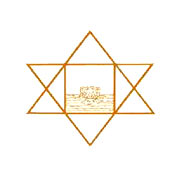Iroquois democracy
How Native American 'Great Law' helped foster American democracy
by Lynda Lester
A thousand years ago, as legend tells, the Iroquois people living in what is now the Northeastern United States were experiencing a dark age of crime, dishonesty, blood feuds, and war.
One day a man named Deganwidah, a Huron with extraordinary spiritual powers and a vision of peace, landed on the shore of Lake Ontario. Enlisting the aid of Hiawatha, he journeyed from tribe to tribe, meeting with the strongest leaders. He convinced them that survival depended on cooperation, and proposed a system of government based on the union of independent states.
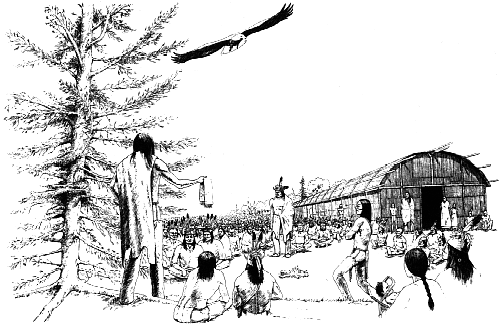
So well did Deganwidah accomplish his mission that he became known as the Peacemaker. His code of justice, the Great Law of Peace, united the Iroquois in the League of Five Nations (Mohawks, Oneidas, Onondagas, Cayugas, and Senecas; the Tuscaroras joined in 1715, becoming the sixth nation.)
Fundamental democratic principles
Meticulously transmitted from generation to generation by oral tradition, the Great Law, or Constitution of the Five Nations, was based on fundamental democratic principles. Government was divided into three branches—executive (with veto power), legislative, and judicial—and structured with a system of checks and balances. Leaders were regarded as servants of the people, subject to impeachment for errant behavior.
Under the law, provisions were made for political representation and participation, universal suffrage, the right to assemble, freedom of speech and religion, and equitable distribution of wealth.
Iroquois communalism put the welfare of the family, tribe, or nation above that of the individual. However, the fierce individuality of Indian character and its resistance to subjugation was also expressed in the Great Law, which assumed the right of all entities to be free. The Iroquois system stressed personal liberty and its attendant responsibilities, while minimizing governmental interference in people's lives.
Strong individualism, mistrust for authority, and respect for divergent ideas, cultures, and religions were indigenous to America long before the arrival of the first Europeans.
Influence of Native Americans on European immigrants
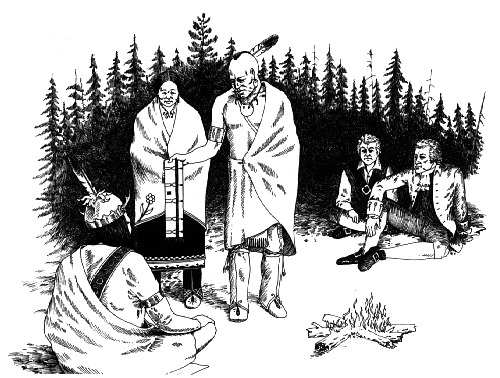
From the first Thanksgiving dinner, Native Americans influenced the culture of the European immigrants. Iroquois neighbors taught the new settlers what to eat, how to dress, how to survive, and exposed them to startling political ideas.
Nothing in the feudal societies and empires of the Old World resembled the democratic Constitution of the Five Nations. Freedom of speech, not a strong point of European monarchy, was vital to Iroquois participatory government. Freedom of religion—unknown across the Atlantic, where genocidal religious wars raged—was guaranteed by the Great Law. Initiative, referendum, recall, and political participation by women, inconceivable in the kingdoms of Europe, were essential to the Iroquois system.
By mid-18th century, several generations of British subjects had been born in America. Influenced by the exigencies of life in a new land and commerce with the Native Americans, the colonists were beginning to feel more American than European. They began to seek alternatives to the rigid class stratification and old political mores of Europe.
Iroquois alliance with Britain
It was at this time Britain realized the need for an Iroquois alliance. The Iroquois were critical to the fur trade, exerted strong diplomatic influence on other Indians, held the entire frontier against the French, outnumbered the colonists, and wielded a formidable military strength.
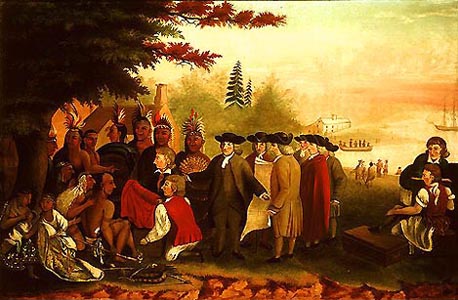
The Crown chose some of the colonies’ leading citizens to seek Iroquois favor and start an extensive program of trade and diplomacy. Since mail service was unreliable and expensive, and phone and telegraph were yet to be invented, the only way to do this was face to face.
A series of treaty councils followed. Due to Iroquois influence on the architects of the American Revolution, these would be among the most important encounters of the century. Prevailing Enlightenment opinion held the Indians to be the intellectual and moral peers of the Euro-Americans. Iroquois leaders were regarded as statesmen from co-equal, sovereign nations.
Thus, when delegates of both cultures mingled—in official sessions and in convivial, off-the-record meetings—they learned from each other. The atmosphere was rich with ideas, shared experience, and philosophical exchange. This was especially the case from 1738–1763, when Britain’s need for an alliance against France increased appreciation of Indian culture.
At this critical moment in history, British subjects and Iroquois mixed freely, sharing each others’ lives. Many held dual citizenship and were fluent in both languages. Treaty councils were attended by Indians with English names and by Englishmen so much a part of Indian life they feIt at home in either society.
Canassatego and Ben Franklin
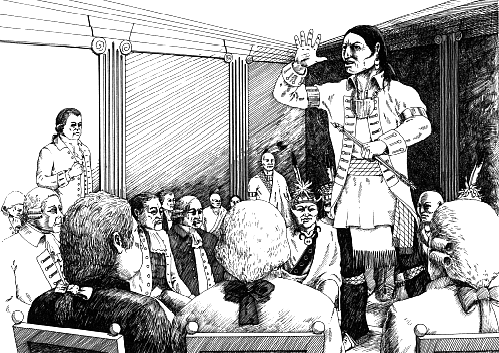
On the Iroquois side of the council chamber, one man with an uncanny understanding of the colonists was Canassatego. Unusually tall and muscular, Canassatego was a skilled orator with a resonant voice. The dignity and power of his speech, along with his commanding presence, gave him a powerful charisma. Conversation stopped when he entered a room.
On the English side, one man with an avid interest in the Iroquois was a printer from Philadelphia named Benjamin Franklin. Involved with the Native Americans first as a publisher of treaty accounts and then as a diplomatic envoy, Franklin picked up Native American ideas on natural rights, federalism, and the nature of society that nurtured his developing revolutionary theory.
At a 1744 treaty council, Iroquois chiefs suggested the colonies could better serve the Anglo-Iroquois alliance by combining into a single federal union. Franklin published Canassatego's closing speech:
Our wise forefathers established Union and amity between the Five Nations. This has made us formidable. This has given us great weight and authority with our neighboring Nations. We are a powerful Confederacy, and by your observing the same methods our wise forefathers have taken you will acquire much strength and power; therefore, whatever befalls you, do not fall out with one another.
Franklin's Albany Plan of Union
By 1750, the political and economic interests of the colonists were diverging from those of the Crown. Franklin began to envisage a form of political union that could serve 12 independent and mutually suspicious colonies. The Iroquois Confederacy, which let each state manage its own internal affairs and gave responsibility to the federal government for common, interstate matters, served as a convenient model.
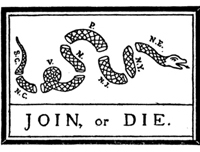
In 1754 an intercolonial conference convened in Albany, a town nestled on the frontier between the British and Indian nations. Delegates from both met to finalize negotiations in their alliance against the French, and to devise and ratify a plan of self-government for the colonies.
Supporting the Six Nations’ advocacy of a colonial union, Franklin submitted a plan that took into account Britain's demands for control (a president-general to be appointed by the Crown), but gave internal sovereignty to the separate colonies, joining them in a loose union similar to the Iroquois Confederacy.
Citing “the strength of the League which has bound our Friends the Iroquois together in a common tie which no crisis, however grave, since its foundation has managed to disrupt,” Franklin told the delegates:
It would be a strange thing if Six Nations of Ignorant Savages should be capable of forming a Scheme for such an Union and be able to execute it in such a manner, as that it has subsisted Ages, and appears indissoluble, and yet a like union should be impracticable for ten or a dozen English colonies.”
(In the parlance of the day, “ignorant” simply meant unschooled, while “savage” often had a positive connotation, referring to man in a state of nature.)
After extensive debate, Franklin’s Albany Plan of Union was approved by the colonial delegates. However, the proposal was rejected by the Crown as too democratic, while the colonial legislatures, unwilling to transcend provincialism, rejected the plan as too restrictive.
Birth of the U.S. Constitution
It would be nearly 20 years before the colonies, incited to action by the Stamp Act and other inflammatory measures imposed by the British, would heed the advice of Franklin and Canassatego.
Ben Franklin would repackage his Albany Plan as the Articles of Confederation, and the Continental Congress would convene in Philadelphia. Thomas Jefferson, who shared Franklin’s respect for Iroquois thought, would borrow Native American ideas of natural rights, liberty, and happiness, freedom of action and expression, and consent of the governed to draft the Declaration of Independence.
In 1787 the colonies would ratify a document that would alter and inspire the world. The Constitution of the United States of America outlined unique democratic principles and created a government unlike anything that had been conceived in Europe.
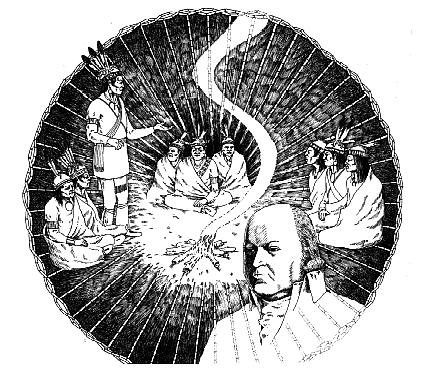
To the Iroquois, however, the ideas of federal union, representation, separation of powers, and individual freedom were familiar concepts—a legacy bequeathed to them long ago by the Peacemaker and revered and followed for centuries as the Great Law of Peace.
Sources
- Johansen, Bruce. Forgotten Founders: Ben Franklin, the Iroquois and the Rationale for the American Revolution. Gambit, Inc., lpswich, MA: 1982.
- Johnson, Tim. “Indians Trace Roots of Constitution.” Daybreak, Vol. 1, Issue 1, Autumn 1987.
- Morris, Glenn T. “Constitution Owes Much to Native Americans.” Rocky Mountain News, Sept. 28, 1987.
- Mohawk, John. “We the Original People: A Celebration of the Principles of Democracy.” Daybreak, Vol. 1, Issue 1, Autumn 1987.
- “The Great Law—U.S. Constitution.” Akwesasne Notes, Vol. 19, No. 4, Summer 1987.
_____________
This article was originally published in Boulder Community Free School magazine in 1988 and appears here in a slightly revised version.
Image credit: Above drawings of the Iroquois are by John Kahionhes Fadden in Exemplars of Liberty: Native America and the Evolution of Democracy by Donald Grinde, Jr. and Bruce Johansen, 1990.
